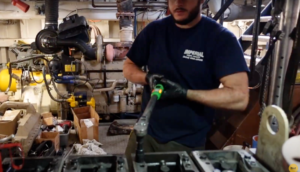
Understanding the Lubrication System for Cummins KTA19
The lubrication system in the Cummins KTA19 engine is crucial for ensuring smooth operation, reducing wear, and prolonging engine life. This system minimizes friction between moving parts, cools engine components, removes contaminants, and helps maintain optimal performance under various operating conditions.
Parts Catalog for Cummins KTA19 Marine Engine
Oil Pump & Related components for Cummins KTA19 Engine
The primary components of the KTA19 lubrication system include:
- Oil Pump: Responsible for circulating oil throughout the engine.
- Oil Filter: Removes impurities and contaminants from the oil.
- Oil Cooler: Regulates oil temperature, preventing overheating.
Each of these components plays a vital role in maintaining engine health, and understanding how they function together is key to effective maintenance.
How the Oil Pump, Oil Filter, and Oil Cooler Work Together
Oil Pump
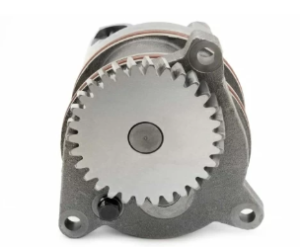
The oil pump generates the necessary pressure to circulate oil throughout the engine. It draws oil from the sump and pushes it through the oil filter and cooler before it reaches critical engine components such as the crankshaft, camshaft, and pistons.
Oil Filter
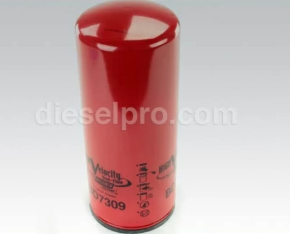
After the oil is pressurized by the pump, it flows through the oil filter. The filter captures dirt, metal particles, and other contaminants that could damage engine parts. A clean oil filter ensures that only purified oil reaches the engine components.
Oil Cooler
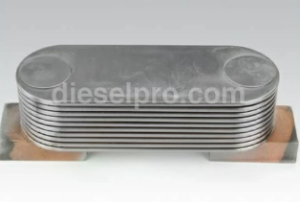
The oil cooler reduces the temperature of the circulating oil, maintaining it within an optimal range. This prevents the oil from breaking down due to excessive heat, which can reduce its lubricating properties and lead to engine damage.
Together, these components ensure that clean, cool, and pressurized oil is continuously supplied to the engine, safeguarding against wear and overheating.
Common Lubrication-Related Failures in Cummins KTA19
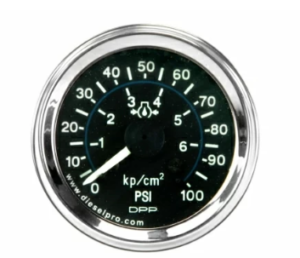
1. Low Oil Pressure:
- Symptoms: Engine warning lights, unusual noises, and poor performance.
- Causes: Worn-out oil pump, clogged oil filter, oil leaks, or low oil levels.
2. Oil Contamination:
- Symptoms: Increased engine wear, dirty oil, and reduced engine efficiency.
- Causes: Faulty oil filters, coolant leaks into the oil, or improper maintenance.
3. Overheating of Engine Components:
- Symptoms: High engine temperature readings, smoke from the engine, or burnt oil smell.
- Causes: Failing oil cooler, insufficient oil levels, or restricted oil flow.
Oil Pump Inspection and Replacement for Cummins KTA19
Regular inspection of the oil pump is critical to ensure it operates efficiently. Here are the steps to inspect and replace the oil pump:
Inspection Steps:
- Visual Check: Look for signs of oil leaks, cracks, or damage to the pump housing.
- Pressure Test: Measure oil pressure using a gauge to confirm it meets manufacturer specifications.
- Check for Wear: Inspect gears, rotors, and internal clearances for signs of excessive wear.
Replacement Procedure:
- Drain the engine oil.
- Remove the oil pan to access the pump.
- Unbolt the oil pump from its mounting position.
- Install the new pump, ensuring proper alignment.
- Reinstall the oil pan and refill with clean engine oil.
Note: Always refer to the Cummins KTA19 service manual for detailed instructions.
Diagnosing Low Oil Pressure in Cummins KTA19

Low oil pressure can cause severe engine damage if not addressed promptly. Follow these diagnostic steps:
- Check Oil Level: Ensure the engine has sufficient oil.
- Inspect for Leaks: Look for external oil leaks around seals, gaskets, and fittings.
- Verify Oil Pressure Sensor: Test the sensor to rule out false readings.
- Examine Oil Filter: Replace a clogged or dirty filter.
- Test Oil Pump: Measure oil pressure directly at the pump output.
Removing and Inspecting the Oil Pump in Cummins KTA19
Removal Procedure:
- Turn off the engine and allow it to cool.
- Drain the engine oil.
- Remove the oil pan to expose the oil pump.
- Unbolt the oil pump from the engine block.
- Carefully remove the pump, avoiding damage to surrounding components.
Inspection Checklist:
- Housing: Check for cracks or deformities.
- Gears/Rotors: Inspect for wear, scoring, or damage.
- Clearances: Measure internal clearances against manufacturer specs.
- Drive Mechanism: Ensure the pump drive is secure and functioning properly.
Reinstalling with Proper Alignment for Cummins KTA19
Proper alignment during reinstallation is crucial to prevent oil flow restrictions:
- Clean all mounting surfaces.
- Apply a light coat of engine oil to the pump gears.
- Position the pump correctly, aligning it with the drive mechanism.
- Tighten mounting bolts to the specified torque.
- Reinstall the oil pan and refill the engine with fresh oil.
Oil Cooler and Filter Head Servicing for Cummins KTA19
Servicing the Oil Cooler:
- Drain the Cooling System: Prevent coolant from mixing with oil during removal.
- Remove the Oil Cooler Assembly: Disconnect oil lines and unbolt the cooler.
- Inspect for Damage: Look for cracks, corrosion, or leaks.
- Clean the Cooler: Flush with a recommended solvent to remove debris.
- Reinstall: Ensure proper gasket placement and secure all connections.
Servicing the Oil Filter Head:
- Remove the oil filter and inspect the filter head for damage.
- Clean the filter head using a lint-free cloth.
- Check for blockages in oil passages.
- Replace any worn-out gaskets or seals.
- Reinstall the filter head and attach a new oil filter.
Checking for Blockages and Leaks in Cummins KTA19
- Visual Inspection: Look for oil stains, wet spots, or drips.
- Pressure Test: Verify consistent oil pressure throughout the system.
- Clean Passages: Use compressed air to clear any blockages in oil lines.
- Seal Checks: Inspect seals and gaskets for wear and replace if necessary.
Best Practices for Oil Filter Changes in Cummins KTA19
- Use Quality Filters: Always choose filters that meet Cummins specifications.
- Regular Replacement: Follow maintenance schedules for timely filter changes.
- Proper Installation: Lubricate the gasket with clean oil before installing the new filter.
- Tighten Correctly: Hand-tighten, then an additional 3/4 turn to ensure a proper seal.
- Check After Installation: Run the engine and check for leaks around the filter.
Disclaimer: For critical lubrication components like the oil pump, follow the official service manual instructions for disassembly and reinstallation.
Parts Catalog for Cummins KTA19 Marine Engine
Oil Pump & Related components for Cummins KTA19 Engine



 Free US Calls: 1-888-433-4735
Free US Calls: 1-888-433-4735 International: 305-545-5588
International: 305-545-5588